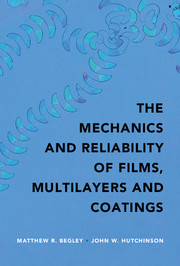Book contents
- Frontmatter
- Contents
- Acknowledgements
- Notation
- 1 Introduction
- 2 Key Mechanics Concepts
- 3 Linear Elastic Fracture Mechanics
- 4 Steady-State Delamination of Bilayers
- 5 Steady-State Delamination in Multilayers
- 6 Steady-State Channeling and Tunneling Cracks
- 7 Crack Kinking from an Interface
- 8 Crack Penetration, Deflection or Arrest?
- 9 Edge and Corner Interface Cracks
- 10 Buckling Delamination
- 11 Delamination of Thin Strips (Patterned Lines)
- 12 Delamination in Multilayers Subject to Steady-State Temperatures
- 13 Cracking under Transient Temperature Distributions
- 14 Software for Semi-Infinite Multilayers: Steady-State Delamination
- 15 Software for Semi-Infinite Multilayers: Transient Delamination
- 16 Finite Element Software for Multilayers: LayerSlayer FEA
- 17 Convergence and Benchmarks with LayerSlayer FEA
- Appendix Asymptotic Crack Tip Displacement Fields for an Interface Crack
- References
- Index
16 - Finite Element Software for Multilayers: LayerSlayer FEA
Published online by Cambridge University Press: 13 July 2017
- Frontmatter
- Contents
- Acknowledgements
- Notation
- 1 Introduction
- 2 Key Mechanics Concepts
- 3 Linear Elastic Fracture Mechanics
- 4 Steady-State Delamination of Bilayers
- 5 Steady-State Delamination in Multilayers
- 6 Steady-State Channeling and Tunneling Cracks
- 7 Crack Kinking from an Interface
- 8 Crack Penetration, Deflection or Arrest?
- 9 Edge and Corner Interface Cracks
- 10 Buckling Delamination
- 11 Delamination of Thin Strips (Patterned Lines)
- 12 Delamination in Multilayers Subject to Steady-State Temperatures
- 13 Cracking under Transient Temperature Distributions
- 14 Software for Semi-Infinite Multilayers: Steady-State Delamination
- 15 Software for Semi-Infinite Multilayers: Transient Delamination
- 16 Finite Element Software for Multilayers: LayerSlayer FEA
- 17 Convergence and Benchmarks with LayerSlayer FEA
- Appendix Asymptotic Crack Tip Displacement Fields for an Interface Crack
- References
- Index
Summary
Previous chapters have frequently pointed out that certain aspects of fracture inmultilayers require complete solutions for stress distributions close to the crack tip. Important examples include mode mix, channeling/tunneling cracks, crack kinking and features with finite length (such as edge cracks or ligaments). While analytical solutions have been presented for a few important cases, a numerical approach is often needed even for relatively simple geometries.
Finite element analysis (FEA) is a well-suited approach, as it is capable of handling virtually any geometry, and all relevant crack tip parameters can be computed using this approach. The fact that both commercial and freeware codes are widely available begs the question as to why we have even bothered to provide an FEA code. Surely, many analyses – especially those involving complicated effects such as plasticity or crack face contact – can be conducted with existing codes. While this is true, there are two important considerations that make a stand-alone code worthwhile.
First, and most importantly, an accurate analysis of cracking in thin films often requires specialized meshes that can be cumbersome to create with other tools. Here, meshing software is provided that is specifically tailored to the analysis of thin film systems with cracks. We provide complete ‘model generators’ that define the geometry, create appropriate meshes and specify all boundary conditions and loading with an absolute minimum of user input. Second, the software also provides efficient, accurate and reliable subroutines to postprocess the results to calculate crack tip parameters. Such computations are by no means universally available in commercial codes. In these two important aspects, there is considerable computational expertise is embedded in the codes, which makes multilayer analysis accessible to those without significant experience with other codes.
Although the provided code lacks the ability to analyze complex geometries and material response, it is highly efficient, both with regard to the effort required for comprehension and for use. Specifically, the software is designed for automation, such that one can set up and analyze hundreds of possible multilayer/crack configurations in minutes. The prepackaged analysis modules (largely) focus on rectangular layers with straight cracks that run along interfaces or perpendicular to the layers.
Information
- Type
- Chapter
- Information
- The Mechanics and Reliability of Films, Multilayers and Coatings , pp. 227 - 254Publisher: Cambridge University PressPrint publication year: 2017
